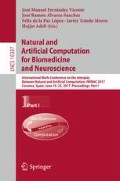Abstract
This paper describes a comparative study of performance of two models predicting surface quality in high-speed milling (HSM) processes using two different machining centers. The models were created with experimental data obtained from two machine-tools with different characteristics, but using the same experimental model. In both cases, work pieces (probes) of the same material were machined (steel and aluminum probes) with cutting parameters and characteristics proper of production processes in industries such as aeronautics and automotive. The main objective of this study was to compare surface quality prediction models created in two machining centers to establish differences in outcomes and the possible causes of these differences. In addition, this paper deals with the validation of each model concerning surface quality obtained, along with comparing the quality of the models with other predictive surface quality models based on similar techniques.
Access this chapter
Tax calculation will be finalised at checkout
Purchases are for personal use only
References
Ahmad, N., Janahiraman, T.V.: Modelling and prediction of surface roughness and power consumption using parallel extreme learning machine based particle swarm optimization. In: Cao, J., Mao, K., Cambria, E., Man, Z., Toh, K.-A. (eds.) Proceedings of ELM-2014 Volume 2. PALO, vol. 4, pp. 321–329. Springer, Cham (2015). doi:10.1007/978-3-319-14066-7_31
Altintas, Y., Weck, M.: Chatter stability of metal cutting and grinding. CIRP Ann. Manuf. Technol. 53, 40–51 (2004)
Badu, S., Vinayagam, B.: Surface roughness prediction model using adaptive particle swarm optimization (APSO) algorithm. Intell. Fuzzy Syst. 28, 345–360 (2015)
Benardos, P., Vosniakos, G.: Predicting surface roughness in machining: a review. Int. J. Mach. Tools Manuf. 43, 833–844 (2003)
Correa, M., Bielza, C., Ramírez, M., Alique, J.R.: A Bayesian network model for surface roughness prediction in the machining process. Int. J. Syst. Sci. 39, 1181–1192 (2008)
Correa, M., Bielza, C., Pamies-Teixeira, P.: Comparison of Bayesian networks and artificial neural networks for quality detection in a machining process. Expert Syst. Appl. 36(3), 7270–7279 (2009)
D‘Mello, G., Pai, S.: Prediction of surface roughness in high speed machining: a comparison. Proc. Int. J. Res. Eng. Technol. 1, 519–525 (2014)
Ezugwua, E., Faderea, D., Onney, J., Bonney, J., Silva, R., Sales, W.: Modelling the correlation between cutting and process parameters in high-speed machining of Inconel 718 alloy using artificial neural network. Int. J. Mach. Tools Manuf. 45, 1375–1385 (2005)
Flores, V., Correa, M., Alique, J.R.: Modelo Pre-Proceso de predicción de la Calidad Superficial en Fresado a Alta Velocidad basado en Soft Computing. Revista Iberoamericana de Automática e Informática Industrial RIAI 8(1), 38–43 (2011)
Friedman, N., Geiger, D., Goldszmit, M.: Bayesian network classifiers. Mach. Learn. 29, 131–161 (1997)
Hao, W., Zhu, X., Li, X.: Prediction of cutting force for self-propelled rotary tool using artificial neural network. J. Mater. Process. Technol. 180, 23–29 (2006)
Izamshah, R., Yuhazri, M., Hadzley, M., Amran, M.: Effects of end mill helix angle on accuracy for machining thin-rib aerospace component. Appl. Mech. Mater. 315, 773–777 (2013)
Jiang, B., He, T., Gu, Y., et al.: Method for recognizing wave dynamics damage in high-speed milling cutter. Int. J. Adv. Manuf. Technol. (2017). doi:10.1007/s00170-017-0128-1
Lela, B., Bajie, D., Jozié, S.: Regression analysis, support vector machines, and Bayesian neural network approaches to modelling surface roughness in face milling. Adv. Manuf. Technol. 42, 1082–1089 (2009)
MacQueen, J.: Some methods for classification analysis of multivariate observations. In: Proceedings of the 5th Berkeley Symposium on Mathematical Statistics and Probability, pp. 281–297 (2003)
Shang, S., Li, J.: Tool wear and cutting forces variation in high-speed end-milling Ti-6Al-4V alloy. Int. J. Adv. Manuf. Technol. 46, 69–78 (2010)
Ozel, T., Esteves, A., Davim, J.: Neural network process modelling for turning of steel parts using conventional and wiper inserts. Int. J. Mater. Prod. Technol. 35, 246–258 (2009)
Ramírez-Cadena, M., Correa, M., Rodríguez-González, C., Alique, J.R.: Surface roughness modeling based on surface roughness feature concept for high speed machining. Am. Soc. Mech. Eng. Manuf. Eng. Div. 16(1), 811–815 (2005)
Soleimanimehr, H., Nategh, M., Amini, S.: Modelling of surface roughness in vibration cutting by artificial neural network. Proc. World Acad. Sci. Eng. Technol. 40, 386–390 (2009)
Stone, M.: Cross-validatory choice and assessment of statistical prediction. J. Roy. Stat. Soc. 36, 111–147 (1974)
Zhou, L., Cheng, K.: Dynamic cutting process modelling and its impact on the generation of surface topography and texture in nano/micro cutting. In: Proceedings of IMechE-2009, vol. 233, pp. 247–266 (2009)
Zuperl, U., Cus, F.: Optimization of cutting conditions during cutting by using neural networks. Robot. Comput. Integr. Manuf. 19, 189–199 (2003)
Acknowledgments
The authors want to thank the collaboration of Nicolás Correa S.A for the use of the M-Versa machining center made in the company, particularly thank Dr. Andrés Bustillo from Nicolás Correa S.A., who enabled experimentation in the company. The authors also thank the Centro de Automática y Robótica at CSIC (Spain), where the rest of the experimentation was made using Kondia machine-tool, as part of the team from Ghame group belonging to this center.
Author information
Authors and Affiliations
Corresponding author
Editor information
Editors and Affiliations
Rights and permissions
Copyright information
© 2017 Springer International Publishing AG
About this paper
Cite this paper
Flores, V., Correa, M., Quiñonez, Y. (2017). Performance of Predicting Surface Quality Model Using Softcomputing, a Comparative Study of Results. In: Ferrández Vicente, J., Álvarez-Sánchez, J., de la Paz López, F., Toledo Moreo, J., Adeli, H. (eds) Natural and Artificial Computation for Biomedicine and Neuroscience. IWINAC 2017. Lecture Notes in Computer Science(), vol 10337. Springer, Cham. https://doi.org/10.1007/978-3-319-59740-9_23
Download citation
DOI: https://doi.org/10.1007/978-3-319-59740-9_23
Published:
Publisher Name: Springer, Cham
Print ISBN: 978-3-319-59739-3
Online ISBN: 978-3-319-59740-9
eBook Packages: Computer ScienceComputer Science (R0)

